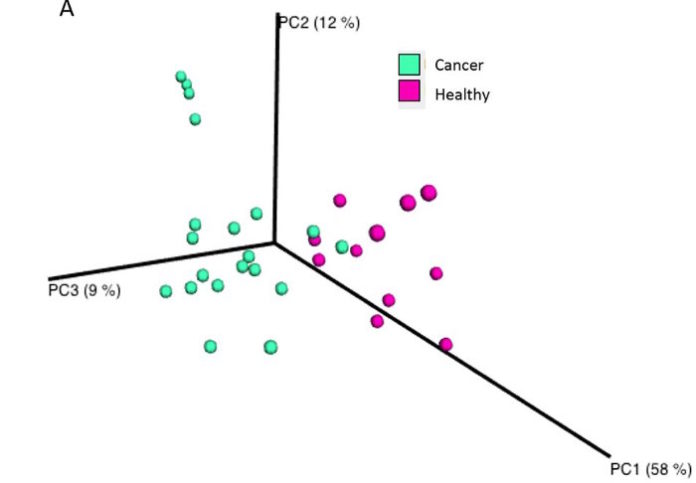Microbial infection is implicated in an ever-growing number of types of cancer. Adding to the already long list of microbial-associated cancers, an increasing body of evidence suggests breast cancer may also be associated with a specific microbial milieu. A report in Applied and Environmental Microbiology confirms that the breast tissue microbial inhabitants differ between women with and without breast cancer.
Could bacterial colonization be one of the many factors that increase risk of developing breast cancer? To test the microbiome of different types of breast tissue, first author Camilla Urbaniak and senior scientist Gregor Reid received samples from 71 women: 45 with cancerous tumors, 13 with noncancerous tumors, and 23 with no tumors. The scientists examined the breast tissue surrounding the tumors, and not the tumors themselves. The bacteria associated with the tissues were assessed by 16S rRNA gene sequencing after amplification.
The scientific team observed a clear difference in microbial inhabitants of the women with breast cancer compared to the women without. Using a UniFrac plot (see right), the researchers measured the similarity between samples and plotted it as a measure of distance from other samples. The samples from the women with cancer (green circles) and from the women without cancer (red circles) form separate clusters, showing a similarity within the group and differences from the other group.
What bacteria did they find? Among other differences, the scientists observed that women with cancer showed higher levels of Escherichia coli and Staphylococcus aureus, while the women without cancer showed higher levels of Lactobacillus and Streptococcus species.
Some E. coli strains harbor a pks pathogenicity island in their genome, and pks-containing E. coli have been implicated with some colon cancers due to their ability to cause double-stranded DNA breaks in surrounding host cells. An increased number of DNA breaks also increases opportunities for a poorly repaired break, which may add to cancerous cell proclivities (since cancer is often a disease of multiple mutations). Using the pks E. coli isolated from the breast tissue, the research team confirmed that this strain also increases double-stranded DNA breaks in cell culture.
Can women influence their breast microbiome to prevent high levels of E. coli or S. aureus colonization? Studies support that drinking microbially fermented products, such as kefir, is associated with lower risk of breast cancer. Orally ingested Lactobacillus bacteria protect animals from experimentally developing cancer ($), but there are no results supporting this claim yet in humans. Future studies may demonstrate a role for probiotics as a preventative measure against breast cancer.
Skeptical readers may be hesitant to conclude that breast tissue bacteria contribute to cancer, and there are many additional experiments to show causation still needed. However, if the link is an association caused by the cancer itself, the findings still provide a noninvasive way to monitor women for their breast cancer risk that might assist breast examinations and mammograms, as pictured at the top (source) as screens for early cancerous growth. For younger women (those under 45), mammograms are recommended after discussing other risk factors, such as family history of cancer. Characterizing one’s breast microbiome may inform the decision to schedule a mammogram.
It took Reid and his colleagues years to convince the scientific world that breast tissue is a niche that harbors microbes. This research confirms his team’s earlier work and identifies bacteria that may play a role in breast cancer development. The hope is that these discoveries will move into therapeutics, diagnostics, and preventative measures to protect the 1 in 8 women who will develop breast cancer during their lifetimes.
Source: ASM



















































